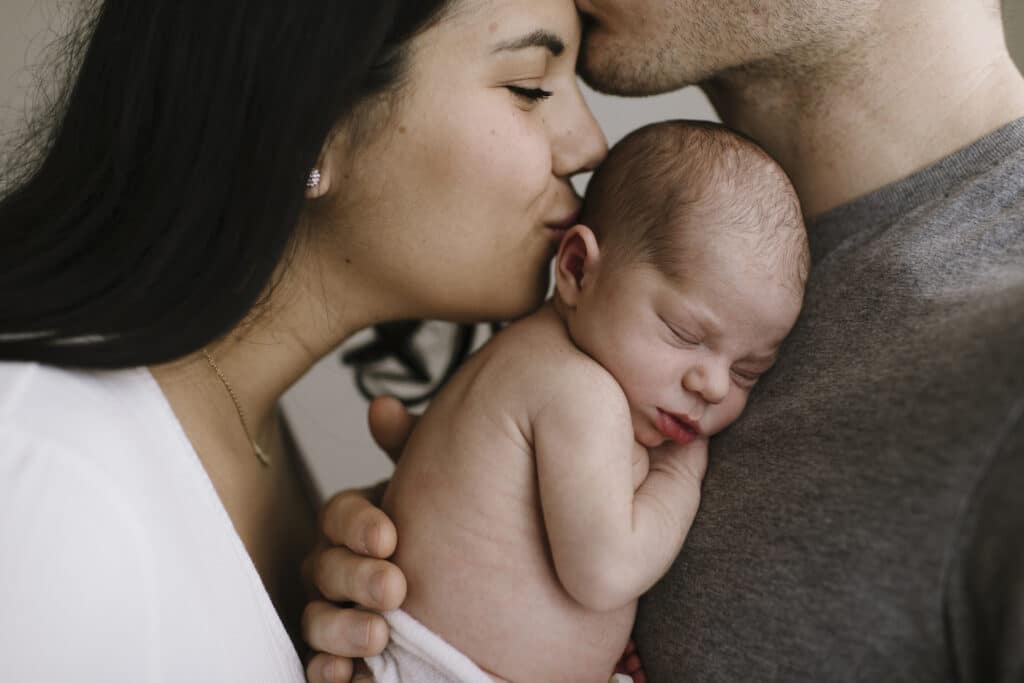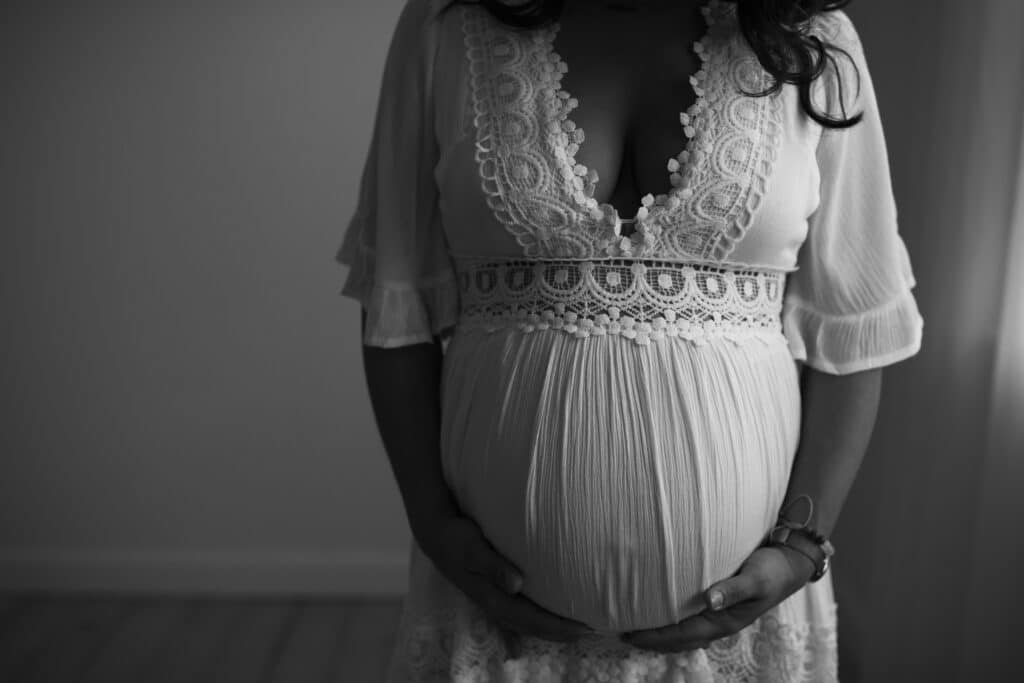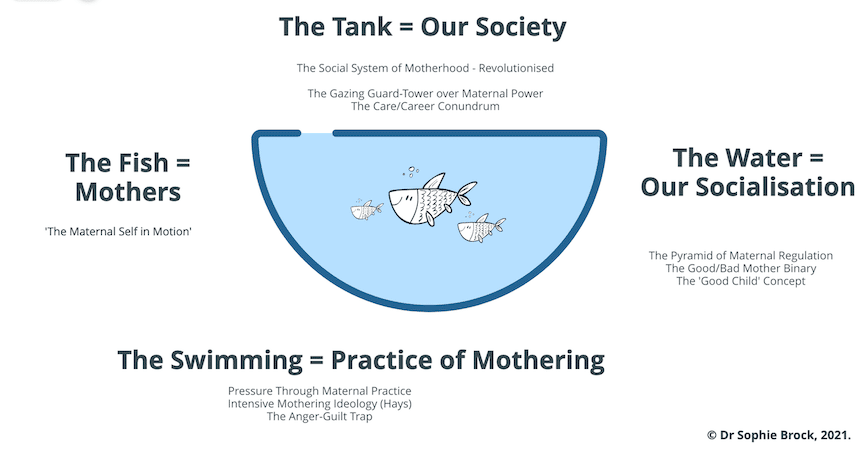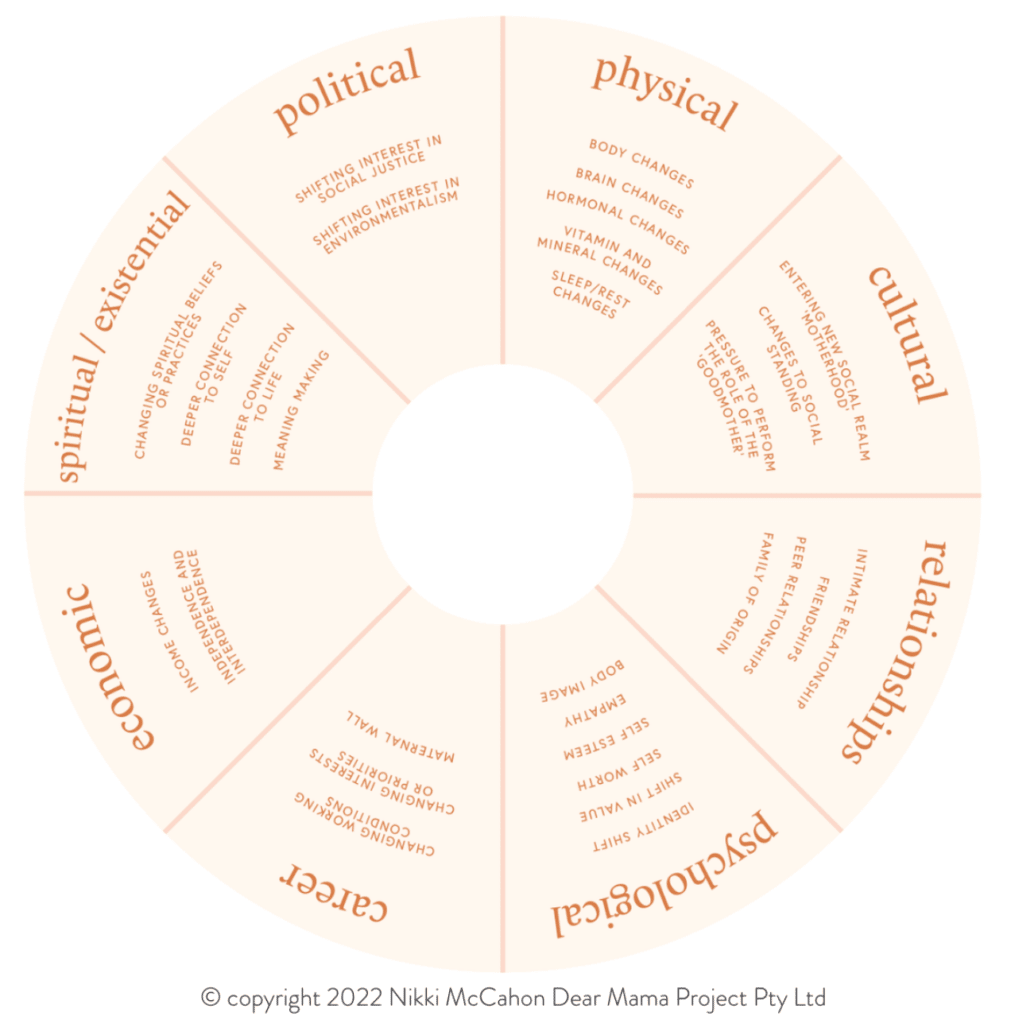Everyone’s heard that “motherhood changes you.” Of course, it does. It’s a new role and time in your life. But there’s more to the changes you experience as you transition to motherhood. Having children changes women in ways we don’t expect and often don’t understand. It wasn’t until I discovered the concept of matrescence that I grasped the idea that motherhood transforms us – and it’s okay to feel different after having children.
Today I’m giving you a quick look at matrescence and why it’s such an important concept to mothers, our communities, our families, and even our employers.
What is Matrescence?
Becoming a mom doesn’t happen in a singular moment, like when your child is born or the first time you lock eyes with your newborn, and it hits you that this is real. Motherhood is a journey full of transitions and changes that happen throughout our lives as parents. Dana Raphael, Ph.D., was the first to name this process matrescence.
Dr. Aurélie Athan, Ph.D, revived the term in 2008, and described matrescence as “the developmental passage where a woman transitions through pre-conception, pregnancy, and birth, surrogacy or adoption, to the postnatal period and beyond.”
Many women feel unsettled in some way after becoming mothers. Whether it’s in their careers, their relationships, or elsewhere. Motherhood disrupts our lives in ways that are hard to understand and that can feel overwhelming, shaking us off balance. The truth is that all mothers change as we progress through our motherhood journeys. But each of us experiences those changes uniquely.
Change and transition are normal. When mothers recognize that we’re constantly changing, we can create space for growth and self-discovery. And when the people around us recognize that, they can also learn how to support mothers better.
As matrescence educator Nikki McCahon said, “Matrescence gives us a framework and lens to explore both challenge and growth in the journey to and through motherhood.”

Seasons of Matrescence
In her Seasons of Matrescence® model and teacher training, McCahon stresses that motherhood is a universal experience and a unique journey – We all experience it in our own ways. And, as I said earlier, motherhood doesn’t happen overnight. The initial transition to motherhood can take two to three years!
As we experience motherhood and move through its transitions and changes, we as moms are constantly experiencing new layers of matrescence. With each season of motherhood, we renegotiate and reorganize our identities and values. Through each of those seasons, women deserve support. After all, we’re forever “new mothers.” With each phase of our children’s development, moms share a cascading impact.
Why is Understanding Matrescence Important?
When someone turns 18, you don’t hand them keys to a car, a mortgage, and taxes to do and say, “Here you go!” Yet, we expect a woman who gives birth to leave the hospital with a newborn and know what she’s doing. She’s supposed to know not just how to care for her newborn but how to translate her mothering into all areas of her life.
It’s not a realistic expectation. It sets women up to fail. It sets families up to fail. And it even sets employers up to fail.
The problem is, today, we see motherhood presented as either a perfect, Pinterest-worthy blissful existence or the absolute opposite: depressing, anxiety-ridden grief. They’re two extreme ends of a spectrum constantly shifting for each of us as we move through our motherhood journeys.
Matrescence helps women recognize that motherhood is full of changes, changes that many women go through. As we experience those changes, we are no longer the same women we were before: And there’s nothing to feel guilty or wrong about in that.
When we, and the people around us learn that, it opens the doors to more compassion and self-compassion. We can reduce the guilt and shame we feel during the more challenging seasons of motherhood and explore more ways to provide support and create safe spaces for moms.

Matrescence & Workplaces
When workplaces recognize women have changed in motherhood, they can create better support systems for those employees as they transition back into the workplace after maternity leave or a career break. This isn’t just positive for working mothers but also benefits employers.
When a working mom returns after maternity leave, without adequate support, she might leave her role. That creates a challenge for her employer: Not only do they have to cover for the work she would be doing, but they might risk productivity and profits. They’re tasked with posting the job, hiring for the position, and giving the new hire the roughly six months it takes to acclimate to a new position.
Instead of losing employees to motherhood, businesses can create better systems that increase employee retention and satisfaction, and support prospective employee attraction.
Matrescence and Mothers Today
Dr. Sophie Brock, the Motherhood Studies Sociologist I studied with to become a certified practitioner of Motherhood Studies, created the Fish Tank of Motherhood Model as a way to illustrate the role of the mother in our modern (Western) society. It’s essential to understand the role matrescence can play in understanding the world women face when they become mothers.
In the Fishtank Model of Motherhood©, shown below, mothers are the fish in the tank. We see that we mothers have been socialized to do our mothering (“The Swimming”) within the context of “The Tank,” which is our society. This model gives us the language to understand that we “perform” our roles as mothers based on societal expectations, otherwise known as the things we “should” do to be a “good mom.”
When we choose to go against the grain of what is expected of a “good mother” (ie, not be self-sacrificing all of the time, or putting our needs first), we’re putting cracks in the tank. These “cracks” appear when we push back against the expectations of patriarchal motherhood and name the things we want to see change: like voicing the need for paid maternity leave, or demanding access to affordable childcare. And when we can wrap our heads around “the tank” we’re in, we can better support each other in our experiences as moms.

You’ll see in the Fishtank of Motherhood Model© that Dr. Brock references The Maternal Self in Motion© or the concept of how we each move through life and its experiences. I will give you another analogy Dr. Brock uses (it’s a good one!)
You can picture your maternal self in motion as one of your kids’ toys, a train, and its track(s). Imagine you’re one of those toy trains, and the cargo you carry is your foundation. Becoming mothers is one track we might go in, and it stops at different stations – our self, where we develop through our own life experiences.
At some stations, there might be grief or loss, career, friendships, etc. And at others, we might offload or release some of our cargo or add to what we’re carrying… Just as motherhood can be a catalyst for our healing or processing or add to what we’re dealing with.
There might also be obstacles in our way on some tracks. And the tracks we choose are different from the tracks someone else travels. We can’t relate to them unless we go down them ourselves, just as we can’t fully understand someone else’s journey because we aren’t on it.
Understanding The Changes We Experience in Matrescence
When we become mothers, we might experience changes in eight different domains, or aspects, of our lives. Nikki McMahon’s Matrescence Matrix™ & Seasons of Matresncece® theory names these areas as
- Physical
- Cultural
- Relationships
- Psychological
- Career
- Economic
- Spiritual/ existential
- Political
Not every mother experiences changes in each of these areas. Our matrescence experience is influenced by our own personal factors as well as social and cultural factors. There are different periods of development in motherhood.
Privilege plays a big role in our unique matrescence experiences. There are different periods of development, some faster than others, and some that will be felt harder by some women than others. For example, a white, middle-class mother with health insurance who is in a heteronormative relationship with a supportive family living in the area, may mostly experience the physical aspects of matrescence. On the other hand, a mother who identifies as queer and is single and a person of color will be up against different changes and challenges and may feel pressure or changes in multiple domains of the Matrescence Matrix.

Let’s explore the areas of change (the domains of matrescence) a bit further:
Physical Changes
Physical changes may relate to conception, pregnancy, birth, and/or postpartum. It relates to how our bodies change, our hormones fluctuate, and even changes to our brains. Yes, Mom Brain is real – It’s when our brains create new neural pathways when we become mothers! Physical changes also include fluctuations in your vitamins and minerals, sleep and rest, and body image.
Most women who experience physical changes in motherhood will do so when pregnant or in the early postpartum period. You might still worry about your weight in 20 years, but it’s not likely that it will be primarily related to motherhood.
Cultural Changes
When women become mothers, people start treating us differently. Every culture has different expectations of what motherhood is. In Western society, a great example you might have seen recently is the heat Finland’s Prime Minister, Sanna Marin, who was lambasted on social media for photographs of her clubbing recently. She’s the leader of a country and a mother; how dare she dance and have cocktails?!
Often, women will go to great lengths to show that we’re good mothers and to hide our difficulties or behaviors that might be seen as “bad.” Like screen time, for example. I make a point not to hide that I occasionally use screen time to occupy or entertain Audrey – sure, some might say any screen time is “bad,” but we do what works for us in our family.
Relationship Changes
These changes are about more than just your relationship with your partner, though intimate relationships change suddenly after childbirth. It’s also to do with people in your community: Your family and friends. Feeling isolated, or like we don’t have strong support systems, can have much to do with relationship changes in matrescence.

Career Changes
Career changes are a big part of identity shifts in matrescence, mainly due to changes in our daily routines before and after we have children. If you went through your pregnancy with the same commute to work and conversations around the water cooler every day, and suddenly, you’re home – that’s a massive disruption to your daily life. Motherhood also heavily impacts the way you measure your success and achievements professionally.
One of the biggest things I spend time talking with clients about is how we can redefine success and achievement after having children. Those things become harder to measure because there’s no scale to gauge if you’re a “good mother.” There aren’t KPIs or measurable outcomes. And that can be challenging for women to navigate without assistance.
Economic Changes
The economic changes we experience in matrescence are heavily tied to our careers. That’s because there’s a dip in income for women when they become mothers. If you’re familiar with the gender pay gap, you know that women generally make less than men. Well, women that have children make less than single women. And, in fact, women earn less and less with each child.
Spiritual and Existential Changes
When women have children, it’s not uncommon to start questioning their purpose in life. We wonder more about the world and our (and our children’s) contributions to it. You might have heard about seeing the world with new eyes when you have a child, or feeling as if you’re reborn. There’s a spiritual connotation to those notions, tied to transformation in motherhood.
Political Changes
Becoming mothers can lead women to have a greater interest in political matters and causes than before having children. For example, mothers might feel more deeply for the mothers and children impacted by the war on Ukraine than they would have before having children and being mothers themselves. Or, moms may care more about environmentalism after bringing children into the world, as they’re concerned with the world their children will inherit.
Psychological
Psychological changes in matrescence can have a lot to do with our identities and how we see ourselves. I, for example, had an identity firmly rooted in being a career woman before becoming a mom. The changes in my work routines and career accomplishments created cracks in my identity.
Psychological changes can also be shifts in your values or perceived value, self-worth, self-esteem, and even body image, too.

Matrescence and You
As you read through this blog and learn about matrescence, are you feeling like things are starting to make sense?
When I first learned about matrescence, it was like discovering the missing piece in what I was experiencing as a new mom.
You might have felt yourself nodding your head about a couple of the domains in which women change in motherhood. Or feeling inspired by how your workplace might be able to better support moms returning to work.
Remember: In matrescence, your identity in motherhood is constantly changing. It’s okay for different seasons to have highs and lows, and for some to be challenging. It doesn’t make you a bad mom or an imperfect mom. It just means you’re one of us.
Sign up for the waitlist for The Motherhood Collective. An 8-week online group program that will help you understand the shifts in your identity, and make sense of your career expectations and aspirations within the context of motherhood.

